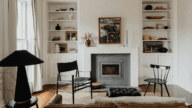6 DIY Dining Room Staging Tips That Preserve a Classic Space
- Published on
- 9 min read
-
 Christine Bartsch, Contributing AuthorClose
Christine Bartsch, Contributing AuthorClose Christine Bartsch Contributing Author
Christine Bartsch Contributing AuthorFormer art and design instructor Christine Bartsch holds an MFA in creative writing from Spalding University. Launching her writing career in 2007, Christine has crafted interior design content for companies including USA Today and Houzz.
-
 Taryn Tacher, Senior EditorClose
Taryn Tacher, Senior EditorClose Taryn Tacher Senior Editor
Taryn Tacher Senior EditorTaryn Tacher is the senior editorial operations manager and senior editor for HomeLight's Resource Centers. With eight years of editorial and operations experience, she previously managed editorial operations at Contently and content partnerships at Conde Nast. Taryn holds a bachelor's from the University of Florida College of Journalism, and she's written for GQ, Teen Vogue, Glamour, Allure, and Variety.
With fewer families eating together at home, some trend watchers have cast the formal dining room as a stuffy relic from the past that sits empty 360 days out of the year.
But according to the National Association of Realtors’ 2023 Profile of Home Staging, 62% of buyers say a staged dining room is important.
Laura Sanders, a top real estate agent in Coral Springs, Florida, with more than two decades of experience echoes: “I had a listing that took me a long time to sell, and the biggest complaint was that it has no formal dining room. I also have other listings without dining rooms in these new build areas, and a lot of people are having a really hard time reselling them.”
So rather than try to showcase versatility with a makeshift game room or den, follow these dining room staging tips that embrace and accentuate the original purpose of the space: eating, entertaining, and bringing family together.
Declutter the table and china cabinet
Formal dining rooms often become a catchall for junk. The table becomes a makeshift office, stacked high with paperwork. The china cabinet becomes the craft cabinet, and the corners are crammed with old toys and under-used exercise equipment.
“Most people are mentally making their decisions to buy based on the listing photos,” says professional stager Jenn McCormac with Carousel Home Staging. “A clean, simple dining room will show well on camera, and make buyers want to come see your property. But a dining room with a desk, office gear, and toys will feel cluttered and confuse your buyer.”
Anything that doesn’t naturally belong in your dining room needs to be packed or tossed, and that includes personal items.
Pack away all of those family photos on the sideboard, that wooden sign featuring your surname on the wall, and those handprint plates your kids made that are displayed in the china cabinet.
When buyers come for a showing or look at your home’s photos online, you want them to envision themselves sitting around the table with family — not wondering about the dining habits of the family that already lives there.
Plus, if your dining room shows signs that you don’t use it, chances are buyers will think that they don’t need the space either.
Deep clean all surfaces and furniture
When you’re prepping your dining room to host your next holiday get-together, you probably have a go-to plan of attack. Brush the crumbs off of the chairs, run a duster over the buffet, slap on a tablecloth to cover the waxy buildup on your dining table’s finish — and you’re good to go.
That level of cleaning may suffice when you’re hosting a family gathering, but when the guests are potentially your home’s future owners, you’re going to want to amp up the effort.
Before you list your home, the dining room needs a thorough, crown molding to baseboard (and everything in between), deep cleaning.
For starters, grab a clean mop with a new head, a bucket of hot water made sudsy with a little dish soap and get to work wiping away those splatters, stains, and fingerprints on the moldings, walls, and baseboards.
Tackle particularly stubborn marks, like crayon scribbles or shoe scuffs with tools specifically designed for the job, like the Mr. Clean Magic Eraser mop. Keep the dust away from your dining room’s moldings and baseboards for the duration of the home sale by running a fabric softener dryer sheet over them.
Finish off the floors by cleaning them with the appropriate tools, cleaning solutions, and techniques for your specific floor type.
Next, it’s time to take on the furniture. To remove water rings or other stubborn stains, you can use household products you have around the house, like baking soda, toothpaste, or salt.
If your dining table and chairs are solid hardwood, the smartest choice to clean them is a silicone-free furniture polish that won’t leave a waxy residue. Restore the look and life of older hardwood dining sets with a furniture oil that both polishes and conditions.
Between dried, caked-on food and beverage stains, cleaning your chair upholstery is the toughest task you’ll take on in the dining room. If your stains are too tough for a standard upholstery cleaner, you may need to rent or buy a carpet cleaner that comes with upholstery attachments. For fabric that’s too far gone, recovering your dining chairs may be your best option. Luckily, dining chairs are easier to reupholster than most furniture, so if you DIY the project, it’ll only cost the price of the upholstery fabric, staples, and extra padding where needed.
Repaint the walls
Dining rooms with a bold, bright accent wall were popular in the early 2000s; red was all the rage. So there’s a good chance that your dining room staging process will call for some fresh paint — plus it’ll cover up any stubborn stains you couldn’t remove.
The best home staging paint colors are beiges, whites, and greiges because neutrals appeal to a large buyer pool.
However, because there’s something romantic about a formal dining room, and these spaces are often used in the evening, you can get away with a darker, more dramatic look in this space than the rest of the house.
Painting the dining room in a separate color will run you up to an additional $600 to $1,040 on average, depending on the size and complexity of the space.
Update your light fixtures
If you’re still eating under the same light fixture the builder installed, it may be time for a new one. The typical price for installing a new light is $548 on average, which is mostly dependent on the cost of the light fixture itself.
Remember that the light fixture is the main focal point of the space that’s staying put after you move — unlike the furniture you’ll be taking with you — so the fixture decision is an important one.
It may be tempting to go with a glammed out statement chandelier, especially if it goes great with your existing dining set, but you’ll want to keep in mind three factors when selecting your dining room light fixture.
Your dining room light fixture should:
1. Reflect the style of the house.
2. Appeal to most buyers.
3. Complement the broadest range of decor styles.
For example, while a fancy chandelier might reflect the formal ambiance of your French Provincial home, it could turn off buyers looking for a more modern vibe. So if you’re trying to sell, pick a more flexible fixture with both modern and formal elements, like this round crystal chandelier or this wide crystal chandelier.
You’ll also want to make sure you pick a fixture that fits the space and hangs at a good height over the table — typically 30 to 36 inches above the tabletop.
As far as the size of the chandelier goes, the ideal size varies depending on the size of the room and the shape of the table. Luckily there are online chandelier size calculators to help you figure out the right light for your dining room.
Deploy the old mirror trick
The mirror trick is a favorite for home stagers when they’re dealing with dining rooms that are on the smaller side or lack natural light.
A massive mirror in a small dining room reflects the space back onto itself, making it appear larger than it actually is. In a similar way, a large mirror reflects existing light in a dark dining room, magnifying its impact on the space. By placing a large mirror directly across from the dining room windows, you’ll amplify the natural light, as well as the artificial light of the chandelier.
“We always hang at least one mirror in the dining room to reflect the light and add some sparkle,” says McCormac.
Create a tablescape
The table dominates the dining room, making it the focal point that’ll draw the buyer’s eye, so you’ll want to set the table as if you were getting ready to serve a feast.
But remember: You’re not actually serving a meal, so less is more. You can get away with just a beautiful centerpiece and a few place settings. You’ll only want between two to six place settings, even for the largest tables that can seat eight to 12 people.
For example, consider a mid-sized rectangular table that seats six in a smaller dining room. Instead of putting place settings at each seat, pull out all but four of the dining room chairs and set only four place settings along the sides rather than on the ends. The table top will look crisp and neat, and the room will look larger without all of the chairs.
“Table settings can feel a little too formal in a lot of today’s houses,” advises McCormac. “Instead, we like to build a tablescape with a table runner and centerpiece. We love an over-the-top centerpiece, like a beautiful collection of faux plants, or a cut-crystal bowl filled with unique orbs that catches the light of a chandelier.”
And feel free to skip the silverware, glassware, serving dishes, and salt shakers, as they’ll only serve to clutter up the table.
To avoid the risk of having your fancy china damaged while strangers are perusing through your home during open houses or showings, pick up some attractive, inexpensive dishware at a discount home goods store. You’ll find a wide selection of options that are sturdy, affordable (without looking cheap), and in a variety of styles to fit any dining room decor — classic, modern, or eclectic.
Once your home is sold, you can either donate these home staging place settings or replace your worn out everyday dishes with the new purchases.
Celebrate the elegance of a formal dining room
Dedicated dining rooms show best as areas for hosting sit-down meals and holiday get-togethers. With these staging ideas from the pros, you can help buyers see the full potential of this classic, formal room.
Header Image Source: (Sarah J/ Pexels)




